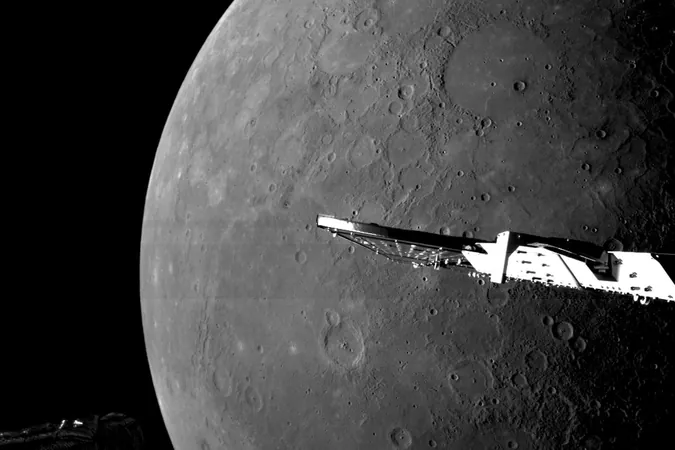
Unveiling Mercury: BepiColombo's Breathtaking Images Reveal Secrets of the Sun's Closest Neighbor!
2025-01-11
Author: Sarah
Groundbreaking Achievement
In a groundbreaking achievement, the BepiColombo spacecraft, a collaborative venture between the European Space Agency (ESA) and the Japan Aerospace Exploration Agency (JAXA), has successfully transmitted stunningly detailed images of Mercury's hidden surface. On Wednesday, during its sixth and final flyby, BepiColombo maneuvered through Mercury's shadow, providing a rare glimpse into its cratered landscape, particularly areas that remain perpetually dark.
The BepiColombo Mission
Launched in October 2018, BepiColombo comprises two interconnected spacecraft designed to conduct in-depth studies of Mercury. This latest flyby brought the spacecraft remarkably close to the planet—just around 180 miles (295 kilometers) above the surface—ushering in a new era of exploration for the solar system's innermost planet. As the mission progresses, it aims for its final orbital insertion in 2026.
Stunning Imagery of Mercury's Surface
From this vantage point, BepiColombo captured striking images of Mercury's surface, starting from its frigid, shadowy night side near the north pole and advancing towards sunlit regions. The spacecraft used its monitoring cameras (M-CAM 1) to explore the pivotal boundary separating the day and night sides of Mercury, unveiling the rims of craters such as Prokofiev, Kandinsky, Tolkien, and Gordimer. These craters not only enhance the planet's rugged terrain but may also veil icy pockets of water—an exciting prospect given Mercury's proximity to the scorching Sun.
Geological Features and Volcanic Activity
Among the geological features unveiled was the massive Caloris Basin, Mercury's largest impact crater, spanning an astonishing 930 miles (1,500 kilometers) across. While Mercury has an overall dark appearance, some of its younger features appear brighter, suggesting a complex geological history. Scientists speculate that the material exposed from below the surface darkens over time due to various space weathering processes.
Additionally, the images recorded highlighted the effects of volcanic activity and significant impacts on Mercury's landscape. One notable feature is Nathair Facula—a bright patch indicative of volcanic activity. Spanning approximately 25 miles (40 kilometers) in diameter, it is the site of repeated eruptions, signifying the dramatic past of this celestial body.
Challenges of Reaching Mercury
The challenges of reaching Mercury are significant due to the intense gravitational influence of the Sun, making BepiColombo only the third spacecraft to successfully study this elusive planet. The mission consists of ESA's Mercury Planet Orbiter (MPO) and JAXA's Mercury Magnetosphere Orbiter (MMO), both of which are set to enter their respective orbits around Mercury by late 2026.
Future Insights and Exploration
Despite the main mission phase still being two years away, insights gained from all six flybys have already enriched our understanding of this little-explored planet. Geraint Jones, BepiColombo’s project scientist at ESA, expressed enthusiasm about the mission, stating, "The next few weeks will see our team working diligently to decode the fascinating data collected from this flyby, as we uncover more of Mercury's secrets."
With each passing moment, the revelations from BepiColombo's mission set the stage for an exciting future in planetary science, potentially altering our understanding of not just Mercury but the formation and evolution of celestial bodies in our solar system.

 Brasil (PT)
Brasil (PT)
 Canada (EN)
Canada (EN)
 Chile (ES)
Chile (ES)
 Česko (CS)
Česko (CS)
 대한민국 (KO)
대한민국 (KO)
 España (ES)
España (ES)
 France (FR)
France (FR)
 Hong Kong (EN)
Hong Kong (EN)
 Italia (IT)
Italia (IT)
 日本 (JA)
日本 (JA)
 Magyarország (HU)
Magyarország (HU)
 Norge (NO)
Norge (NO)
 Polska (PL)
Polska (PL)
 Schweiz (DE)
Schweiz (DE)
 Singapore (EN)
Singapore (EN)
 Sverige (SV)
Sverige (SV)
 Suomi (FI)
Suomi (FI)
 Türkiye (TR)
Türkiye (TR)
 الإمارات العربية المتحدة (AR)
الإمارات العربية المتحدة (AR)